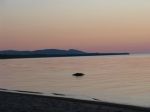
Note: My husband, grandson, and I took a cross-country road trip June 25 to June 29, 2020. I’m belatedly publishing my journal entries.
June 25: I know, we’re crazy: We are driving cross country during the worst pandemic of the century. (“Worst pandemic of the century so far,” Homer Simpson whispers in my ear.) It’s our annual road trip, from our home in Los Angeles to our cabin in Michigan, where my husband was born and I have summered for 50 years (!). In the past half-century, you can count on one hand the number of years we have not spent time in the Upper Peninsula. It’s our individual and combined Ground Zero, our happy place, our Walden, our home. Nonetheless, we seriously considered not going this year, for what I thought was an obvious reason: that five-letter and two-digit word, Covid-19.
But there were compelling reasons: Number one, my mother-in-law’s failing health. Heart attack, heart surgery, stroke, carotid artery surgery, kidney stones, etc.: She has suffered a litany of ailments in the past few years, and my sister-in-laws have shouldered the burden of care. Also, Bud’s daughter is there, his siblings, his friends. And I am hoping against hope that I might get to see — at least through a window — my father in his nursing home in Wisconsin. Usually, summer is the time my immediate family and my extended “Lake family” of friends convene here in Michigan. This year, I don’t know if I will see any of them.
At least I have my grandson. The novel coronavirus has caused all sorts of novel plot twists in people’s lives, and for my husband and I, it has meant taking care of Shine, 9, only child of my stepdaughter Kenda, this summer. After four months of home school and care, his parents, in Miami, must get back to work. So unexpectedly I’ve gotten something I have wished for but never thought would happen: I’m co-director of Camp Gramps. Shine has only been to visit his Michigan family once, when he was an infant. It is time he meets them. So not only are we driving through nine states and half the breadth and depth of the country during a pandemic; we have a grade schooler with us.

Road dogs Shine Hoover and Alexander Hamilton
We are not completely insane. While it is not why we are going, the thought of leaving a county that is constantly in the news as a Covid hotspot, for one that has yet to have a single recorded case of the virus, is certainly appealing. (Update: The first case was confirmed over the July 4 weekend.)
The 2,000 miles in between are admittedly a deterrent. Yet in general, the route has so far been refreshingly virus free, especially compared to LA. Sure, on the infection maps, there are a few orange and red hotspots, but they can easily be driven through — don’t even gas up. We are driving, not flying, and we have planned a trip with as few interactions with people and surfaces as possible. We have a picnic basket and cooler full of food. We are carrying a special purple coronarivus backpack, full of masks, sanitizer, gloves, wipes, etc. We love to experience the American West every summer. But this year, we will enjoy it primarily through the truck windows.

Provisions
Still, if there is one lesson I would want to convey at the end of our journey’s first day, it’s this: Don’t go to Utah.
We stopped just across the border in St. George, one of our usual haunts, perched as it is amid the beautiful red and black rocks of canyon country. But I was shocked when I entered the gas station/Burger King. The usual Mormon broods of seemingly endless blond children always freak me out, but this year they were like pandemic panic horror show poster children, as they filled the tiny bathroom — no social distancing, nary a mask in sight. At the food-ordering line, I had to ask them to back up. Maybe Utahns have so many children they consider them expendable, but I value my only grandson.
Basically, no one in Utah wears masks. Not the desk clerk at the La Quinta Hotel in North Orem, nor the guests, nor the gas station attendants.
No wonder the infection and death rates in Utah are rising — as of June 25, 164 per 100,000 and 5 per 100,000 respectively. The test positivity rate is even more alarming, currently 13.2% and rising.

111 in the desert
Don’t go to Utah.
We loved the scenery as usual, though found the highway surprisingly full. But we sprinted to our hotel room and will slink out in the morning. Here’s hoping the people of Wyoming are a little smarter.



























